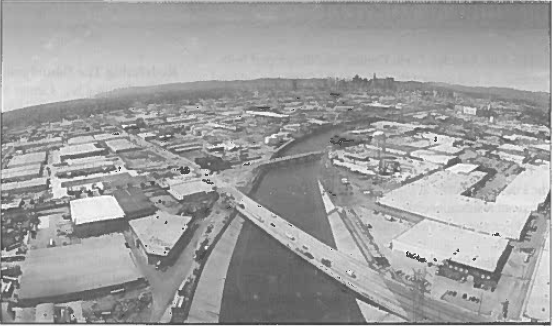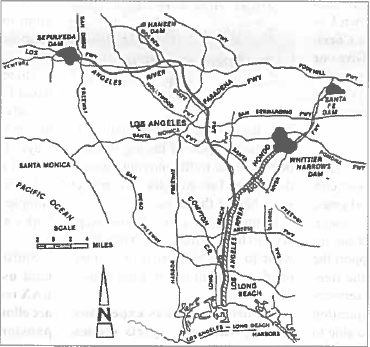By Lewis MacAdams, member, Board of Friends of the Los Angeles River

Lewis MacAdams: “… (R)e-thinking flood protection, cleaning up stormwater, increasing groundwater re-charge, restoring some of the 95% of L.A.’s riparian habitat that has been destroyed, creating urban parks in the metropolitan area… will involve some hard choices.”
Except for the Antelope Valley, Los Angeles County is the watershed of the Los Angeles River. Yet until last month's settlement of a law suit filed by Friends of the Los Angeles River and ten other environmental and community organizations, any comprehensive plan to look at the Los Angeles River watershed seemed out of the question.
Los Angeles County's Department of Public Works had created what they called a Master Plan, but it dealt almost exclusively with coordinating parkland opportunities along the river banks, and avoided dealing with flood protection, stormwater management, habitat restoration and ground-water recharge. Now suddenly, it's as if the floodgates had opened. For the first time since the phlegmatic William Mulholland stood beside the Los Angeles Aqueduct on its opening day in 1913, pointed at the water rushing south from the Owens Valley and grunted, "There it is. Take it,'' the Los Angeles River has reemerged in the public's consciousness.
The Central Library has just opened a beautifully curated show of photos, drawings and historical documents looking at the river's past, present and future - Discovering the River: Perspectives on the Los Angeles River Watershed (thru Jan. 5 '97). The national meeting of the American Society of Landscape Architects at the Convention Center Oct. 19-21 will focus a number of panels and a planning charette on the Los Angeles River.
The Mitsubishi Corporation is sponsoring a panel on the river's future aimed at the downtown business community in the Mark Taper Auditorium of the Central Library at the end of the workday on Nov. 12 (call 213-228-7326 for information). A group of businesses under the leadership of Chris Campbell has formed the So. Calif. Coalition for Pollution Prevention (355 S. Grand Ave. 40th Floor, L.A. 90071) to look at ways to clean up the stormwaters that flow directly into the river through thousands of storm drains.
Dorothy Green, one of the founders of Heal The Bay, has been meeting monthly for the last year with representatives of agencies, cities and environmental and citizen's groups from up and down the river under the name of the Los Angeles & San Gabriel Rivers Watershed Council. If all three Park Bond issues on the Nov. 5 ballot: The City of Los Angeles' Proposition K; L.A. County's Proposition A; and the State's Proposition 204 pass, about $37 million will become available for the greening of the river.
Nothing, however, has offered as much promise for the possibility of fundamental change for the river and its tributaries as the creation—as part of the agreement for the settlement of FOLAR's Lawsuit—of the Los Angeles River Watershed Task Force. The Task Force, which consists of 25 representatives of cities up and down the river, agencies concerned with all aspects of the river on the local, regional, state and federal level, and environmental and community groups; and a steering committee from the L.A. County Dept. of Public Works, the U.S. Army Corps of Engineers, the LACDA (L.A. County Drainage Area) alliance of seven downstream cities in the river's floodplain, the City of Long Beach, the Wrigley (a large neighborhood that sits at the base of the river's levees in Long Beach) Residents Association, Heal The Bay, American Oceans Campaign and Friends of the L.A. River is charged with hiring a consultant to completely re-think flood protection in the Los Angeles Basin.
Utilizing $250,000 from the County, the consultant's first task will be to relook at the alternatives to raising levees and building concrete walls four to eight feet higher on the lower 21 miles of the river. The task Force's second task will be to outline the scope of work for a 1.5 million dollar U.S. Army Corps of Engineers watercourse study. Then, in its second and third year, working with the Los Angeles & San Gabriel Rivers Watershed Council to look at all the issues in the watershed.
Someday, river advocates may look back at the current moment as the era of good feelings, when everybody pays lip service at least to creating a Los Angeles River Greenway from the mountains to the sea. But re-thinking flood protection, cleaning up stormwater, increasing groundwater recharge, restoring some of the 95% of L.A.'s riparian habitat that has been destroyed, creating urban parks in the metropolitan area with the least amount of parkland per capita in the United States will involve some hard choices. Building concrete walls and higher levees along the river is the ugliest, dirtiest & cheapest temporary solution to the threat of floods in Los Angeles.
Everything else will involve land-use decisions which few cities in Los Angeles County have yet had the vision and the courage to make. Probably the most crucial task for all the citizen energy now focusing on the Los Angeles River is creating a constituency for the river that will make the politicians' decisions easier.
- Log in to post comments





